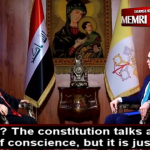By: The Wall Street Journal –
CAIRO—In a desert plain 40 miles east of central Cairo, a sprawling new capital city is taking shape, with skyscrapers, luxury residences and pedestrian malls representing President Abdel Fattah Al Sisi’s vision of a modern Egypt, fueled by billions of dollars in debt to help see it through.
Now comes the hard part: getting people to live and work there.
Egypt is aiming to attract more than six million people to the 270-square-mile area meant to be the new capital. While it is years from completion, with transportation lines still unfinished and a dusty business tower rising from the middle of a construction site, the government plans to start moving 40,000 civil servants into a completed government district in January.
The new city, known as the New Administrative Capital, is estimated to cost tens of billions of dollars and is the centerpiece of Mr. Sisi’s plan for transforming Egypt into a modern country, alongside infrastructure projects such as the expansion of the Suez Canal, a nationwide network of new highways, bridges and tunnels and a resort town along the Mediterranean coast. Mr. Sisi is pursuing these expensive projects—estimated to cost hundreds of billions of dollars—despite Egypt’s ongoing economic crisis. The country faces more than one trillion dollars in domestic and foreign debt in the coming years, according to U.K. research firm Oxford Economics.
Central to Mr. Sisi’s plans for a new megacity on the edges of greater Cairo is shifting the government’s power nexus away from the historic districts near the Nile River, where ancient buildings are crumbling, traffic is congested and residents are densely packed. The new capital’s government district is lined with rows of buildings that evoke ancient Egyptian architecture leading to a large gathering space dubbed the People’s Square, a giant mosque and a presidential palace.
“All of Egypt must be like the new capital and that’s what your dream should be,” Mr. Sisi said in October.
The project began in earnest in 2015, when Egyptian authorities contacted officials in the United Arab Emirates for advice on building and financing a new city. Mr. Sisi unveiled the first model for the new capital alongside Mohamed Alabbar, the developer of the Burj Khalifa tower in Dubai. That partnership fell apart quickly amid disagreement over the financial terms of a joint venture, according to Ayman Ismail, the founding chairman of the entity building the new capital, who has since stepped down but still serves as an adviser.
The Egyptian military then took charge of the project, and a new design by local developers was drawn up that was far less pedestrian-friendly and separated government, business and residential areas.
The new capital is also supposed to include a park running more than 20 miles in length, its own airport and universities. The main business district will have several skyscrapers, including a 78-story one that would be the tallest on the African continent.
From the city’s entryway of Arabesque arches, the tower can be seen half-built in the distance. In a separate financial district, buildings for Egypt’s central bank and other state-run banking institutions still sit on unpaved grounds.
On a September government-led tour of the government district, few people were walking the streets. Some bushes and palm trees had been planted but there was nearly no shade around the People’s Square.
“The government built the new capital to say that we have a modern state and that we look like Dubai,” said Sameh El Alayli, a professor of urban planning at Cairo University. “In reality, it’s a project to show off skyscrapers, rather than address the real needs of the country.”
Mr. Ismail said that populating the city will rest on how fast it can attract business. He believes that both the location of the city near the Suez Canal and the orderly design of the government district will improve work efficiency.
“This project is critical for the country,” he said.
In the financial sector, employees at banks and asset managers said that moving a substantial number of staff to the new capital would take years. Some firms say they are waiting to see the finance regulator and the Egyptian stock market move there first. Most investment banks are clustered in west Cairo, where the Egyptian Exchange and Financial Regulatory Authority are currently based.
Authorities are trying to convince foreign embassies to buy land in a new diplomatic zone. Several foreign diplomats said their embassies would need to see that Egyptian government ministries locate there first. They also want to see the new capital gain traction before they consider whether it is financially and logistically viable to open an office there.
Approaching motor vehicles to the new capital are greeted by colorful billboards marketing high-end condos, some with multiyear payment installments.
David Sims, a Cairo-based urban planner, said he is skeptical about how attractive the city will be for average Egyptians.
“What this involves is having a huge and growing middle class with lots of disposable income,” said Mr. Sims. “It’s just not happening, period.”
Schools, hospitals and restaurants in the new city aren’t yet complete and it is likely to be unaffordable for most impoverished Egyptians.
“I’m being thrown into the unknown,” said Ahmed Salah, 36 years old, an official at Egypt’s ministry of youth and sports, who has visited the new capital a few times but whose office has yet to move permanently. It took him 2½ hours to reach the new city from his home in central Cairo. Mr. Salah and his wife, also a government employee, don’t expect to be able to afford an apartment in the new city.
The Covid pandemic and the war in Ukraine have pushed up food and commodity prices globally, making it more costly for the Egyptian government to import wheat and subsidize bread supplies. Foreign investors have pulled out billions of dollars in investment from Egypt, leaving the country short of U.S. dollars to import goods and sending the Egyptian pound tumbling.
The turmoil forced authorities to seek financial lifelines from the U.A.E., Saudi Arabia, Kuwait and Qatar, as well as the International Monetary Fund. While some deposits and loans have come through, analysts say the government has a lot more debt coming due and will likely have to raise more money.
Egyptian state media reported in 2015 that the new capital will cost a total of $45 billion. In an interview, Khaled Abbas, the chairman of the military-controlled agency running the new capital, said he expected the ultimate amount to exceed that estimate, although he said it was impossible to know by how much more. Mr. Abbas estimates that Egypt has spent more than $20 billion on the new capital so far with the war in Ukraine pushing up the price of building by around 10%-15%.
No one can predict the ultimate bill for the new capital, said Mr. Abbas. “I’m sure it will exceed 45 billion [U.S. dollars]…it changes every day.”
__________________________
Photo: The construction site of the business district in Egypt’s new capital city, which plans to be home to the tallest skyscraper on the African continent. KHALED ELFIQI/SHUTTERSTOCK




